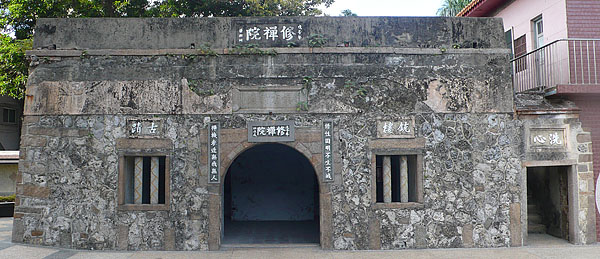Xunfang Fortress
Xunfang Fortress (Xùnfāng Pàotái 巽方砲台)
Throughout most of the Qing Period in Taiwan (18th and 19th centuries), the island had a reputation as a revolutionary hot spot. Both the aboriginals and the Han peasants frequently revolted against the Manchu Qing. For many of the Han peasantry, the Qing were colonial occupiers who administered the island with the same restrictive class divisions that the Japanese would later apply. Both small and large uprisings were frequent, but two rebellions in particular resulted in the Qing securing Tainan’s defenses. In the 1720s rebels took control over and occupied Tainan (then called Taiwanfu). Upon its recovery by the Qing, the first city walls and gates were constructed. Tainan was again taken and occupied temporarily by rebels in 1833, which resulted in more walls being placed in outer wards. Inland fortresses were also constructed in conjunction with these walls.
Xunfang Fortress is the only remaining inland fortress in Tainan. Built in 1836 using granite stones and cement, it was one of two forts guarding the eastern areas beyond the Great East Gate. Outer walls, gates (such as Duiyuemen), and forts were built in response to uprisings in the 1830s. Xunfang Fortress is in the southeast of the city, thus it is named for for the bā guà southeast direction known as xùn.
You would really have to be in-the-know (e.g. readers of this blog) to have any knowledge of this fort. If you traverse the southeast part of the city along Linsen Road every day, you have probably passed by it a million times without ever seeing it. It is hidden away inside of a monastery and from the street there is nothing to tell you that it’s in there.
What’s left of the fort today is a simple rectangular structure approximately 8 meters wide, 5 meters deep and 4 meters high. It has an arched doorway, windows and gun holes. You can both enter the fort and climb to the top, but neither place is really set up for tourism or even well-kept. The inside has been resurfaced with no regard to historic integrity.
Xunfang Fortress is not high on the tourist circuit, but it is a third class national historic site (the same ranking as the Great East Gate) due to its historic importance. It is worth a visit if you’re really interested in forts, or if you think you’ve seen everything in the city.
Location: No.10 Guanghua Street (光華街), East District, Tainan City (inside the monastery)




How do you find this stuff? I’ve been through those back streets (long before that monastery was built) many times and I never noticed that fort. great post.
Amazing find. I second that comment about never knowing it was there. I’ve been here a long time and never even heard about any of those relics still left.
Good one.
Nice photos! And the map is helpful, too.
When I first came to Tainan in 2008, I found a kind of a tourist map somewhere. I can’t remember where I found it. It was completely in Chinese. It had a map of the city on one side, and on the back it had small photos with short descriptions of a number of historical places and structures around the city, including even the smaller structures such as 兌悅門 (DuiYueMen), the Well of Black Africans, and Xunfang Fortress, etc. So, I kept that in my backpack, and as I had time, I eventually found all of those places (and found quite a few more purely by accident!).
Have you ever seen such a map? They really should print an English version.
Hey– with all of your great photos and commentary, maybe you could help them do it?
I’ve seen several tourist maps of Tainan, but none as detailed as the one you’ve described. Certainly, there aren’t a lot of great English publications on Tainan City. I may try to fix that some day, but I doubt there are enough English-speaking tourists to off-set the costs of publication.
An other one to add to my list of things to do next time I go. My wife lived around the corner for more than 20 years and didn’t even know about this.
Thanks to your blog, I am starting to have a long TODO list for my next stay there.